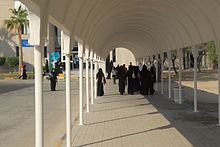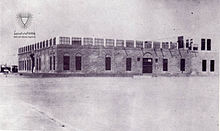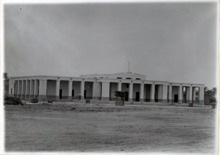Education in Bahrain

The Ministry of Education is responsible for education in the country.
History

Parents who could afford to fund their children's studies often sent them to schools in

Following the end of the
In 1926, a second public school for boys opened up in the capital city, Manama. Two years later, in 1928, the first public school for girls was established. Due to financial constraints suffered by the Education Committee, the Bahraini government took control of the schools in 1930.[3]
Government schools
In the 1991–92 academic year, 99,348 students attended 129
In the academic year of 2008/2009 the number of public classes in Bahrain ( including religious classes) are 4326, with the number of male students 62381 and female students 63233. with a distribution of 62172 in primary classes, 32327 in preparatory classes (junior high) and 31115 in secondary schools.[citation needed]
Private schools

In addition to the American Mission School, another foreign private school was opened in 1910; Al-Ittihad school, funded by the

In addition to the public education system, there are forty-eight private and
In October 2021, Al Hekma International School has agreed upon the Sharakah Agreement[9] with American University of Sharjah (AUS) to encourage students from varied socio-economic backgrounds to be considered for partial scholarships.
Higher education
In 1927 the first group of Bahrainis to receive a university education enrolled at the American University of Beirut in Lebanon.[1] The first institution of higher education in Bahrain, the Gulf Polytechnic, was established in 1968 as the Gulf Technical College.[1] In 1984 Gulf Polytechnic merged with the University College of Art, Science, and Education (UCB), founded in 1979, to create a national university offering Bachelor of Arts and bachelor of science degrees.[1] During the 1991–92 academic year, more than 4,000 students, half of whom were women, studied at the University of Bahrain.[1]
Kingdom University was founded in 2001 and opened in Riffa in 2004.
In 2008 a new Bahrain Polytechnic opened on the University of Bahrain's old campus location at Isa Town.
Bahrain had three additional institutions of higher education in 1993.
The AGU campus has been completed to contain a faculty of medicine, faculty of agriculture and Princess Jawhara of Saudi Arabia donated a centre for molecular biology & inherited disorders. Built right across the street from the campus to encourage the development of regional research in this issue.
Further liberalisation of the education sector has occurred in Bahrain. With new private universities being founded, the Quality Assurance Authority for Education and Training was created to ensure the quality of programs offered by the universities.
The 2010s saw the establishment of the British University of Bahrain in 2018 and the American University of Bahrain in 2019.
See also
References
- ^ OCLC 29548413.)
 This article incorporates text from this source, which is in the public domain.
This article incorporates text from this source, which is in the public domain.{{cite encyclopedia}}: CS1 maint: postscript (link - ^ "Bahrain". CIA - The World Factbook. Retrieved 20 January 2013.
- ^ a b c d "History". Ministry of Education - Bahrain. Archived from the original on 16 August 2013. Retrieved 20 January 2013.
- )
- ^ Gosselink, George. "Annual Report for the Arabian Mission for the Year 1934." Neglected Arabia, Vol VI. Oxford, pg 11.
- ^ a b Shirawi 1987, p. 60.
- ^ Shirawi 1987, p. 60-61.
- ^ Shirawi 1987, p. 61.
- ^ "AUS signs its first regional Sharakah agreement with Al Hekma International School in Bahrain". American University of Sharjah. 2021-10-07. Retrieved 2021-10-12.
- Bibliography
- Shirawi, May Al-Arrayed (1987). Education in Bahrain - 1919-1986, An Analytical Study of Problems and Progress (PDF). Durham University.
